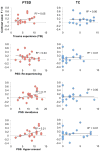Disrupted amygdala-prefrontal functional connectivity in civilian women with posttraumatic stress disorder
- PMID: 23827769
- PMCID: PMC3743923
- DOI: 10.1016/j.jpsychires.2013.05.031
Disrupted amygdala-prefrontal functional connectivity in civilian women with posttraumatic stress disorder
Abstract
Many features of posttraumatic stress disorder (PTSD) can be linked to exaggerated and dysregulated emotional responses. Central to the neurocircuitry regulating emotion are functional interactions between the amygdala and the ventromedial prefrontal cortex (vmPFC). Findings from human and animal studies suggest that disruption of this circuit predicts individual differences in emotion regulation. However, only a few studies have examined amygdala-vmPFC connectivity in the context of emotional processing in PTSD. The aim of the present research was to investigate the hypothesis that PTSD is associated with disrupted functional connectivity of the amygdala and vmPFC in response to emotional stimuli, extending previous findings by demonstrating such links in an understudied, highly traumatized, civilian population. 40 African-American women with civilian trauma (20 with PTSD and 20 non-PTSD controls) were recruited from a large urban hospital. Participants viewed fearful and neutral face stimuli during functional magnetic resonance imaging (fMRI). Relative to controls, participants with PTSD showed an increased right amygdala response to fearful stimuli (p(corr) < .05). Right amygdala activation correlated positively with the severity of hyperarousal symptoms in the PTSD group. Participants with PTSD showed decreased functional connectivity between the right amygdala and left vmPFC (p(corr) < .05). The findings are consistent with previous findings showing PTSD is associated with an exaggerated response of amygdala-mediated emotional arousal systems. This is the first study to show that the amygdala response may be accompanied by disruption of an amygdala-vmPFC functional circuit that is hypothesized to be involved in prefrontal cortical regulation of amygdala responsivity.
Keywords: Amygdala; Emotion; Functional connectivity; Medial prefrontal cortex; PTSD; fMRI.
Copyright © 2013 Elsevier Ltd. All rights reserved.
Conflict of interest statement
The authors declare no conflict of interest, financial or otherwise.
Figures



References
-
- Bernstein DP, Fink L, Handelsman L, Foote J, Lovejoy M, Wenzel K, Sapareto E, Ruggiero J. Initial reliability and validity of a new retrospective measure of child abuse and neglect. American Journal of Psychiatry. 1994;151(8):1132–1136. - PubMed
Publication types
MeSH terms
Substances
Grants and funding
LinkOut - more resources
Full Text Sources
Other Literature Sources
Medical

